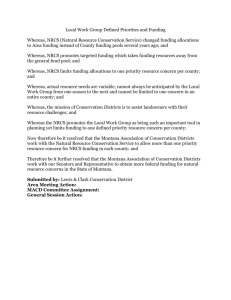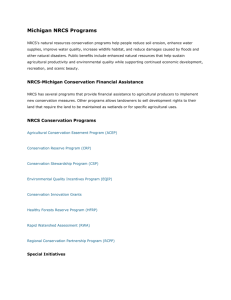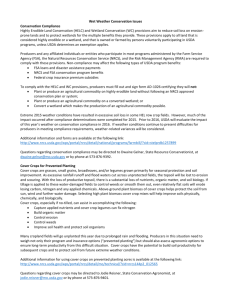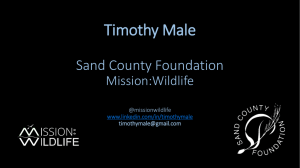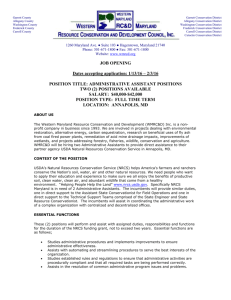An Overview of Forestry in the Farm Bill and Natural
advertisement
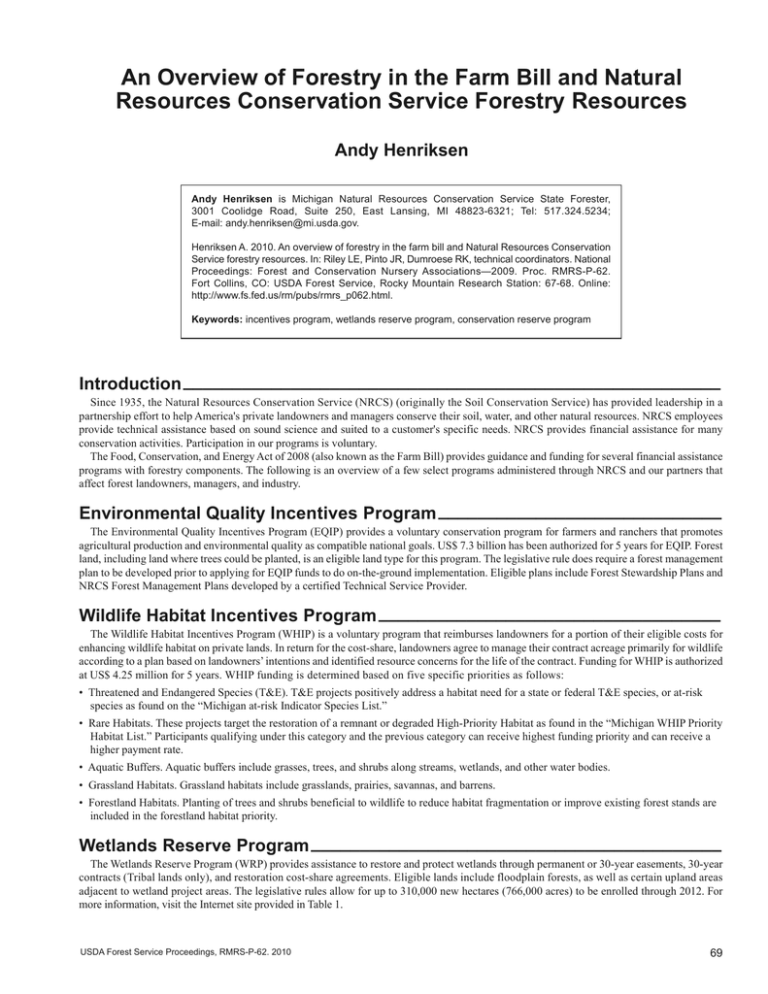
An Overview of Forestry in the Farm Bill and Natural Resources Conservation Service Forestry Resources Andy Henriksen Andy Henriksen is Michigan Natural Resources Conservation Service State Forester, 3001 Coolidge Road, Suite 250, East Lansing, MI 48823-6321; Tel: 517.324.5234; E-mail: andy.henriksen@mi.usda.gov. Henriksen A. 2010. An overview of forestry in the farm bill and Natural Resources Conservation Service forestry resources. In: Riley LE, Pinto JR, Dumroese RK, technical coordinators. National Proceedings: Forest and Conservation Nursery Associations—2009. Proc. RMRS-P-62. Fort Collins, CO: USDA Forest Service, Rocky Mountain Research Station: 67-68. Online: http://www.fs.fed.us/rm/pubs/rmrs_p062.html. Keywords: incentives program, wetlands reserve program, conservation reserve program Introduction _______________________________________________________ Since 1935, the Natural Resources Conservation Service (NRCS) (originally the Soil Conservation Service) has provided leadership in a partnership effort to help America's private landowners and managers conserve their soil, water, and other natural resources. NRCS employees provide technical assistance based on sound science and suited to a customer's specific needs. NRCS provides financial assistance for many conservation activities. Participation in our programs is voluntary. The Food, Conservation, and Energy Act of 2008 (also known as the Farm Bill) provides guidance and funding for several financial assistance programs with forestry components. The following is an overview of a few select programs administered through NRCS and our partners that affect forest landowners, managers, and industry. Environmental Quality Incentives Program _____________________________ The Environmental Quality Incentives Program (EQIP) provides a voluntary conservation program for farmers and ranchers that promotes agricultural production and environmental quality as compatible national goals. US$ 7.3 billion has been authorized for 5 years for EQIP. Forest land, including land where trees could be planted, is an eligible land type for this program. The legislative rule does require a forest management plan to be developed prior to applying for EQIP funds to do on-the-ground implementation. Eligible plans include Forest Stewardship Plans and NRCS Forest Management Plans developed by a certified Technical Service Provider. Wildlife Habitat Incentives Program ___________________________________ The Wildlife Habitat Incentives Program (WHIP) is a voluntary program that reimburses landowners for a portion of their eligible costs for enhancing wildlife habitat on private lands. In return for the cost-share, landowners agree to manage their contract acreage primarily for wildlife according to a plan based on landowners’ intentions and identified resource concerns for the life of the contract. Funding for WHIP is authorized at US$ 4.25 million for 5 years. WHIP funding is determined based on five specific priorities as follows: • Threatened and Endangered Species (T&E). T&E projects positively address a habitat need for a state or federal T&E species, or at-risk species as found on the “Michigan at-risk Indicator Species List.” • Rare Habitats. These projects target the restoration of a remnant or degraded High-Priority Habitat as found in the “Michigan WHIP Priority Habitat List.” Participants qualifying under this category and the previous category can receive highest funding priority and can receive a higher payment rate. • Aquatic Buffers. Aquatic buffers include grasses, trees, and shrubs along streams, wetlands, and other water bodies. • Grassland Habitats. Grassland habitats include grasslands, prairies, savannas, and barrens. • Forestland Habitats. Planting of trees and shrubs beneficial to wildlife to reduce habitat fragmentation or improve existing forest stands are included in the forestland habitat priority. Wetlands Reserve Program __________________________________________ The Wetlands Reserve Program (WRP) provides assistance to restore and protect wetlands through permanent or 30-year easements, 30-year contracts (Tribal lands only), and restoration cost-share agreements. Eligible lands include floodplain forests, as well as certain upland areas adjacent to wetland project areas. The legislative rules allow for up to 310,000 new hectares (766,000 acres) to be enrolled through 2012. For more information, visit the Internet site provided in Table 1. USDA Forest Service Proceedings, RMRS-P-62. 2010 69 Henriksen An Overview of Forestry in the Farm Bill and Natural Resources Conservation Service Forestry Resources Conservation Reserve Program _____ Technical References _____________ The Conservation Reserve Program (CRP) is a voluntary program for agricultural landowners administered through the Farm Services Agency (FSA) with technical assistance provided by NRCS. Through CRP, you can receive annual rental payments and cost-share assistance to establish long-term, resource-conserving covers on eligible farmland. The Commodity Credit Corporation (CCC) makes annual rental payments based on the agriculture rental value of the land, and it provides cost-share assistance for up to 50% of the participant's costs in establishing approved conservation practices. Participants enroll in CRP contracts for 10 to 15 years. Three sign-up options are available under the CRP umbrella: Electronic Field Office Technical Guide • CRP General Sign-up. Producers can offer land for CRP general sign-up enrollment only during designated sign-up periods. A new sign-up is anticipated in the next year; the last sign-up was in 2004. The general sign-up allows for whole field enrollment, and traditionally results in a significant increase in the number of trees planted on private land. • CRP Continuous Sign-up. Environmentally desirable land devoted to certain conservation practices may be enrolled at any time under CRP continuous sign-up. Certain eligibility requirements still apply, but offers are not subject to competitive bidding. • Conservation Reserve Enhancement Program (CREP). The CREP is a voluntary land retirement program that helps agricultural producers protect environmentally sensitive land, decrease erosion, restore wildlife habitat, and safeguard ground and surface water. CREP is available in targeted areas only. Biomass Crop Assistance Program __ The Biomass Crop Assistance Program (BCAP) is administered by FSA. It provides financial assistance to producers or entities that deliver eligible biomass material to designated biomass conversion facilities for use as heat, power, bio-based products, or biofuels. BCAP has two purposes: Provide assistance for the establishment and production of crops for conversion to bioenergy in specific project areas. Information on this portion of BCAP is not yet published; it is anticipated by spring 2010. Assist with collection, harvest, storage, and transportation (CHST) of eligible materials. This portion of the program should be available in late 2009. For more information on BCAP and the 2008 Farm Bill, visit the Internet site provided in Table 1. NRCS Electronic Field Office Technical Guides (eFOTG) are the primary scientific references for NRCS. They contain technical information about the conservation of soil, water, air, and related plant and animal resources, and are organized into five sections: Section I, General Reference; Section II, Soil and Site Information; Section III, Conservation Management Systems; Section IV, Practice Standards and Specifications; and Section V, Conservation Effects. The eFOTG can be accessed at URL: http://www.nrcs.usda.gov/technical/efotg/. Follow the map links. Forestry and nursery professionals might have particular interest in the Conservation Tree and Shrub Group list in Section II, which helps land managers make better decisions about which tree and shrub species to plant on a particular soil. For a wealth of forestry reference material, visit the Internet site provided in Table 1. Web Soil Survey The Web Soil Survey (WSS) is an on-line publically available tool that allows one to identify a specific area of interest on an interactive map and generate custom soil surveys for that property containing user-selected soil data. See Table 1 for the Internet address. WSS is the official repository of soils information, allowing NRCS to constantly update and add to the soils information available. Plant Materials Program The NRCS Plant Materials Program selects conservation plants and develops innovative planting technology to solve the nation's most important resource concerns. The Program includes a network of 27 Plant Materials Centers (PMCs) and associated Plant Materials Specialists serving all 50 states and territories. To date, the program has released more than 600 conservation plants, most being grown by commercial growers. For more than 70 years, PMCs and Specialists have provide essential and effective plant solutions for critical habitats, environmental concerns, management practices, and key farm and ranch programs. For more information on the Plant Materials Program, visit the Internet site provided in Table 1. PLANTS Database The PLANTS Database provides standardized information about the vascular plants, mosses, liverworts, hornworts, and lichens of the US and its territories. It includes names, plant symbols, checklists, distributional data, species abstracts, characteristics, images, crop information, automated tools, onward Web links, and references. See Table 1 for the Internet address. Table 1. NRCS programs and Internet sites. NRCS Programs Internet Sites Wetlands Reserve Program http://www.mi.nrcs.usda.gov/programs/ Biomass Crop Assistance Program http://www.fsa.usda.gov/energy 2008 Farm Bill http://www.nrcs.usda.gov/programs/farmbill/2008/index.html Forestry Reference Material http://www.mi.nrcs.usda.gov/technical/forestry.html Web Soil Survey http://websoilsurvey.nrcs.usda.gov/app/ Plant Materials Program http://plant-materials.nrcs.usda.gov/ PLANTS Database http://plants.usda.gov/ NRCS Home Page http://www.nrcs.usda.gov The content of this paper reflects the views of the authors, who are responsible for the facts and accuracy of the information presented within. 70 USDA Forest Service Proceedings, RMRS-P-62. 2010

